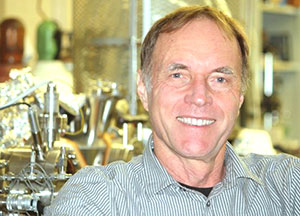
Imagine a super-light material which can be used in novel types of car batteries, in space applications, in high-yield catalysis, or in biomedicine and neuroengineering. Such functional carbonaceous materials with high specific surface areas have become an appealing topic in recent years.
Researchers in Professor Klaus Sattler’s group at the at the University of Hawaiʻi at Mānoa physics department have achieved the synthesis of ultralight foam from carbon with nanoscale pores and extremely low density. This carbon nanofoam is among the lightest materials ever produced. It has a mass density of only 80 mg/cc, which is about 30 times lower than the density of graphite.
Analysis of the foams was performed in collaboration with PhD student Natalie Frese in Professor Armin Goelzhaeuser’s group at the University of Bielefeld in Germany. Helium ion microscopy studies show that the foams are made of micropearls with a nanoporous internal structure. Electronic and vibronic studies reveal that the produced nanofoams are of high quality, made of pure carbon with a cellular continuous atomic network. The results were published in “Ultralight carbon nanofoam from naphtalene-mediated hydrothermal sucrose carbonization” in the scientific journal CARBON.
UH graduate student Amanda Bowers and undergraduate student Shelby Mitchell were involved in the synthesis, which occurred by hydrothermal processing of an aqueous sucrose solution. The researchers found that a tiny amount of added naphthalene acted as a nucleation seed for the foam formation. They also found that the conditions for this formation are very critical with respect to the applied parameters. In hydrothermal carbonization, an organic material is transformed in a high pressure, high temperature autoclave, by a very complex thermodynamic process.
New method leads to high quality foams
The preparation of carbon materials from sucrose does not involve toxic chemicals and can be applied in large-scale applications. The method leads to high quality foams with a continuous micro and nanostructure. The studies show that the foams consist of cavities with walls as thin as one to few layer graphene. Such three-dimensional graphene scaffolds are of great interest for the scientific community, since they combine the properties of the single-layer atomic carbon sheet with a three-dimensional network arrangement.
Sattler’s group is particularly interested in such 3D-graphene architectures since they may have exciting new electronic and mechanical properties. Further research will concentrate on fine-tuning the synthesis and post-treatment and on theoretical computer modeling of three-dimensional single-layer carbon materials.

